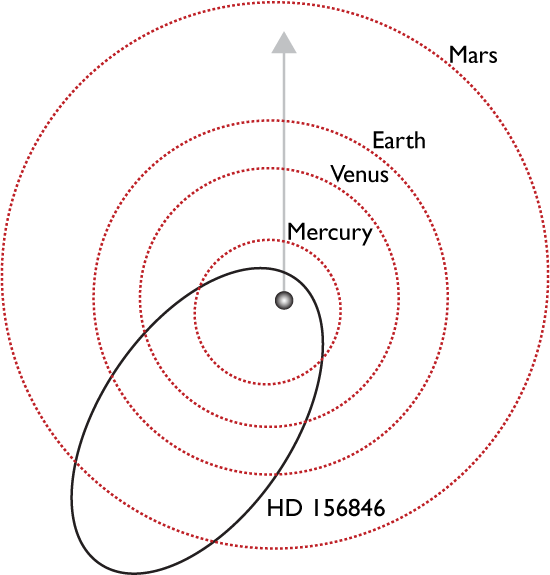Seems like every other year, a good opportunity arises for small-telescope photometric transit observers to participate in a big discovery. In 2007, oklo.org egged everyone on to observe HD 17156 during the transit window of its e=0.69, P=21.2-day planet, and the results were quite satisfactory. In early 2009, there was the exciting detection of the HD 80606b transit. This year, there’s a very interesting opportunity to see whether HD 156846b (RA 17 20 34.31129, DEC -19 20 01.4991, V=6.5) occults its parent star.
HD 156846 b was discovered by the Geneva Team in 2007, and weighs in at a hefty 10+ Jupiter masses. Its orbital period is 359.6 days, just short of a year, and it has a very high eccentricity, e=0.848. The orbital geometry is quite favorable, leading to a ~5% chance that transits will be observable. In addition, the transit window is well constrained as a consequence of the large radial velocity swing that the planet induces in its parent star. Here’s the set-up, with the inner solar system orbits shown for scale:
Observers worldwide should plan to be on the sky this August 23rd, 24th, and 25th, a bit more than three weeks from now. Be sure to check back at oklo.org and to follow twitter.com/transitsearch for updates and interesting details as this opportunity draws near!



I’m interested in monitoring the transit from Staten Island with a 16-inch telescope … any recommendation for an appropriate cadence?
At V=6.5, you’ll probably be forced to use exposures in the 1s ballpark to avoid saturation, depending on how oversampled the PSF is. I’d just observe it continuously, you’ll need a lot of exposures to overcome the Poisson noise from the comparison stars and the scintillation. (N.B. I usually do not recommend defocus, unless you know you can keep the focus perfectly stable and still guide – one or both of these criteria is usually not satisfied by most real systems) I can also recommend doing a proper non-linearity measurement on the CCD beforehand if you have time in case the counts vary significantly during the observation. I think you know my email if you need any more. :)
Well the estimated transit duration, assuming zero impact parameter, is 323 minutes and since
a transit light curve requires something like a minimum of 10 points to be characterized, a minimum cadence would be once every 30 minutes or so. More would be much better so if you can do every few minutes, that would be good. Bruce Gary wrote an online book on transit photometry that is available for free and the link is on Greg’s other website, Transitsearch.